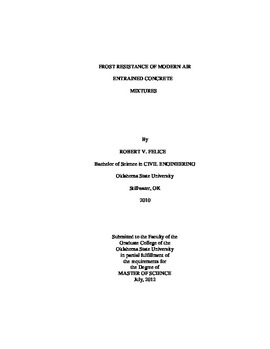| dc.contributor.advisor | Ley, Tyler | |
| dc.contributor.author | Felice, Robert Vincent | |
| dc.date.accessioned | 2014-04-17T19:55:56Z | |
| dc.date.available | 2014-04-17T19:55:56Z | |
| dc.date.issued | 2012-07-01 | |
| dc.identifier.uri | https://hdl.handle.net/11244/10118 | |
| dc.description.abstract | This work consists of two main studies. The first study is to observe the impact of w/cm, three types of air entraining admixtures (AEA), and a midrange (lignosulfonate) water reducing admixture (WRA) have on concrete air void systems and frost performance. The second study focused on a 0.45 w/cm concrete that used wood rosin AEA and a polycarboxylate super plasticizer (PC). The second study looks to investigate how to regenerate fresh air content and workability lost in concrete treated with a PC to achieve satisfactory frost performance. Concrete mixtures for this study were made in a climate controlled laboratory environment. Mixtures were prepared using locally available aggregates used in commercial concretes (ASTM C 33), a Type I/II cement (ASTM C 150), and admixtures (ASTM C 260 and C 494). A standard mixing procedure was used and is discussed in the respective experimental methods sections corresponding to each study. To investigate the hardened concrete parameters the surface of samples were prepared in accordance to ASTM C 457, and scanned under a CCD camera. The first study determined that a concrete air content of 3.5% was needed for satisfactory frost performance in mixtures where AEA was the only admixture. It was observed that in concretes prepared with higher doses of midrange water reducer, 4.5% concrete air contents were needed for satisfactory frost performance. The second study found that the current guidelines used for air contents are not conservative for concretes treated with PCs. The addition of PC was shown to severely coarsen the air void system requiring concrete air contents near 8% for frost durability. Remixing modifications (remixing alone, remixing plus water, and remixing plus more polycarboxylate) were used to regenerate lost air contents. Frost durability was seen in these mixtures by remixing alone and remixing with water. Remixing with additional PC did not provide frost durable mixtures for this study. | |
| dc.format | application/pdf | |
| dc.language | en_US | |
| dc.publisher | Oklahoma State University | |
| dc.rights | Copyright is held by the author who has granted the Oklahoma State University Library the non-exclusive right to share this material in its institutional repository. Contact Digital Library Services at lib-dls@okstate.edu or 405-744-9161 for the permission policy on the use, reproduction or distribution of this material. | |
| dc.title | Frost Resistance of Modern Air Entrained Concrete Mixtures | |
| dc.type | text | |
| dc.contributor.committeeMember | Russell, Bruce W. | |
| dc.contributor.committeeMember | Emerson, Robert N. | |
| osu.filename | Felice_okstate_0664M_12313.pdf | |
| osu.college | Engineering, Architecture, and Technology | |
| osu.accesstype | Open Access | |
| dc.description.department | School of Civil & Environmental Engineering | |
| dc.type.genre | Thesis | |
| dc.subject.keywords | air entraining admixture (aea) | |
| dc.subject.keywords | air-voids | |
| dc.subject.keywords | freeze-thaw | |
| dc.subject.keywords | lignosulfonate | |
| dc.subject.keywords | minimum concrete air | |
| dc.subject.keywords | polycarboxylate | |
